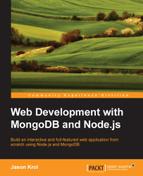In this book, you will find a number of styles of text that distinguish between different kinds of information. Here are some examples of these styles, and an explanation of their meaning.
Code words in text, database table names, folder names, filenames, file extensions, pathnames, dummy URLs, user input, and Twitter handles are shown as follows: "Make sure you've npm installed all of the required modules for this chapter and that they are saved to your package.json file."
A block of code is set as follows:
models.Image.aggregate({ $group : {
_id : '1',
viewsTotal : { $sum : '$views' }
}}, function(err, result) {
var viewsTotal = 0;
if (result.length > 0) {
viewsTotal += result[0].viewsTotal;
}
next(null, viewsTotal);
});When we wish to draw your attention to a particular part of a code block, the relevant lines or items are set in bold:
.upload-button {
border-bottom: solid 2px #005A8B;
background: transparent $sprite-bg no-repeat;
@include radius(4px);
cursor: pointer;Any command-line input or output is written as follows:
$ node server.js Server up: http://localhost:3300 Mongoose connected.
New terms and important words are shown in bold. Words that you see on the screen, in menus or dialog boxes for example, appear in the text like this: "Users demand more from their apps these days, and if you think about the application we've written, the Like button is a perfect example."
